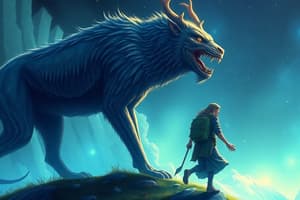Podcast
Questions and Answers
What is the definition of Evolution?
What is the definition of Evolution?
- Formation of new species.
- How well an organism can survive and reproduce in an environment.
- Selective breeding of plants and animals.
- Change over time; the process by which modern organisms have descended from ancient organisms. (correct)
What is Speciation?
What is Speciation?
Formation of new species.
What is Artificial Selection?
What is Artificial Selection?
Selective breeding of plants and animals to promote the occurrence of desirable traits in offspring.
Define Natural Selection.
Define Natural Selection.
What is meant by Adaptation in biology?
What is meant by Adaptation in biology?
Describe Fitness in evolutionary terms.
Describe Fitness in evolutionary terms.
What are Homologous Structures?
What are Homologous Structures?
Define Analogous Structure.
Define Analogous Structure.
Explain Sexual Selection.
Explain Sexual Selection.
What defines a Species?
What defines a Species?
What is Reproductive Isolation?
What is Reproductive Isolation?
Define Behavioral Isolation.
Define Behavioral Isolation.
What is Geographic Isolation?
What is Geographic Isolation?
What is a Vestigial Structure?
What is a Vestigial Structure?
Who is Charles Darwin?
Who is Charles Darwin?
Flashcards are hidden until you start studying
Study Notes
Evolutionary Concepts
- Evolution is the process through which modern organisms evolve from ancient ancestors over time.
- Speciation refers to the formation of new species through evolutionary processes.
- Artificial selection involves selective breeding of organisms to encourage desirable traits in their offspring.
- Natural selection, or survival of the fittest, is a mechanism where organisms best adapted to their environment are more likely to survive and reproduce.
- Adaptation encompasses heritable characteristics that enhance an organism's chances of survival and reproduction in its environment.
Organism Fitness
- Fitness measures how well an organism can survive and reproduce in a specific environment.
- Homologous structures are anatomical features that share a similar form in different species due to common ancestry.
- Analogous structures serve similar functions across different species but do not share common origins, indicating convergent evolution.
Selection in Reproduction
- Sexual selection occurs when individuals favor mates based on heritable traits, affecting reproduction patterns.
- A species is defined as a group of similar organisms that can interbreed and produce fertile offspring.
Mechanisms of Isolation
- Reproductive isolation occurs when populations are separated and can no longer interbreed, leading to the evolution of distinct species.
- Behavioral isolation happens when differences in mating rituals or behaviors prevent two populations from breeding.
- Geographic isolation is caused by physical barriers (like rivers or mountains) that separate populations, resulting in the formation of subspecies.
Remnant Structures
- Vestigial structures are inherited from ancestors but have lost much or all of their original function, indicating evolutionary change.
Historical Figure
- Charles Darwin, known as the "father of evolution," began his significant journey on the HMS Beagle in 1831, contributing foundational ideas to evolutionary theory.
Studying That Suits You
Use AI to generate personalized quizzes and flashcards to suit your learning preferences.




